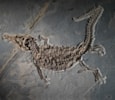Extraordinary Prehistoric Crocodilian
Extraordinary Prehistoric Crocodilian
Eocene, C. 55.8-48.6 million years ago
Fossil
H:163 x W:213 cm
Sold
The creature is positioned exactly as found, seemingly swimming in the bluish limestone matrix, its head pointed to the surface, three small Knightia fish dart around. The quality of the preservation is remarkable, the scutes (shield-like scales), fine bones and even the teeth all remain in their original position. The leg bones are rounded and have a wonderful, butterscotch colour. This fossil originates from the Fossil Butte Member (FBM), a subdivision of Fossil Lake, one of the three Eocene lakes which formed part of the Green River Formation (GRF). Located in modern-day Utah, Wyoming and Colorado, the GRF is one of the most important fossil sites world-wide. Now arid, it was a luxuriant lake basin teeming with life during the Eocene. The consistently warm and humid climate was favourable to the development of an incredible biodiversity. These weather conditions were notably adapted to the survival of crocodylomorphs. As the lakes dried with climate change, the numerous plants and animals living in the area became extinct, turning the site into the fossiliferous desert it is today. Some of the world’s most beautiful and well-preserved fossils have been recovered from the Fossil Butte Member, and the quality of fossils originating from this location is such that they have been described as “portraits”. According to palaeontologist Lance Grande they are “snapshots of extinct life”, a statement perfectly befitting the present piece, which is full of life and realism. The present fossil originates from the 18-inch layer, one of the most celebrated localities of the FBM. It has been described as one of the “mother lode” layers of the Green River Formation for palaeontologists. More specifically, the present example was recovered from the bottom cap, a part of the 18-inch layer which is particularly renowned for its bone preservation and lack of compression, producing the most spectacular, high-quality specimens. Thanks to the density and abundance of contemporaneous fossils found in the 18-inch layer, it is of particularly importance for the study of biodiversity and interactions between species at the Green River Formation. Lance Grande has described it as “the best picture of life in the Early Eocene that has ever been discovered.” The Borealosuchus wilsoni is a crocodylomorph species which roamed the Green River Formation lakes between 55.8 and 48.6 million years ago. It is particularly associated with Wyoming. Despite their form, the Borealosuchus are not Crocodylia – an order which comprises notably of modern-day crocodiles, alligators and caimans. However, both seem closely related and the high degree of preservation of Borealosuchus fossils make them crucial to the scientific understanding of the evolution of crocodylomorphs. Among these, the B. wilsoni is the youngest species and undoubtedly the best known, thanks to the high level of preservation of its fossils. B. wilsoni is the largest of the two crocodylomorphs known from the Fossile Butte Member. The most common findings in the FBM are isolated teeth, with complete skeletons and skulls rarely recovered. About a dozen examples are known and they have been largely undescribed. B. wilsoni was Fossil Lake’s top predator and would prey on turtles, fishes, and any other animal which could provide it substantial sustenance.
Filming of discovery on 14 May 2019 and excavation available
David Aaron Ltd, 2023, No. 35
Discovered on 14 May 2019 at the South Clear Creek Fossil Quarry, Lewis Ranch, Lincoln County, Wyoming, USA. With signed document from the landowner.
ALR: S00218144, with IADAA certificate, this item has been checked against the Interpol database.










 Enquire
Enquire




